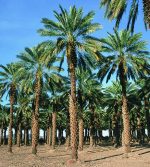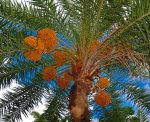 Date palm is a tender evergreen tree that probably orginated in the Fertile Crescent and has been cultivated since 7,000 BC. It is a member of the palm family, Arecaceae, that also includes coconut and palmettos. The trees grow up to 75′ tall and has one to several stems carrying pinnately compound leaves are 13-20′ long and have spines on the petiole and up to 150 leaflets that are up to 12″ long. The leaves are produced at the stop of the stems and form a crown that is 20-33′ across. Spikes of small white male and female flowers are produced in the axils of the leaves on different plants and fertilized female flowers give way to yellow to red, oval fruits that are 1-3″ long and very sweet. Date palms are grown as street trees as well as for shade and fruit, and may be grown in a container as a patio or house plant. The genus name, Phoenix, was the classical Greek name for the plant. The specific epithet, dactylifera, comes from the Greek word dactylos meaning finger, and the Latin word ferre meaning to carry, and refers to the finger-like appearance of the leaves. Photo Credit Wiktionary
Date palm is a tender evergreen tree that probably orginated in the Fertile Crescent and has been cultivated since 7,000 BC. It is a member of the palm family, Arecaceae, that also includes coconut and palmettos. The trees grow up to 75′ tall and has one to several stems carrying pinnately compound leaves are 13-20′ long and have spines on the petiole and up to 150 leaflets that are up to 12″ long. The leaves are produced at the stop of the stems and form a crown that is 20-33′ across. Spikes of small white male and female flowers are produced in the axils of the leaves on different plants and fertilized female flowers give way to yellow to red, oval fruits that are 1-3″ long and very sweet. Date palms are grown as street trees as well as for shade and fruit, and may be grown in a container as a patio or house plant. The genus name, Phoenix, was the classical Greek name for the plant. The specific epithet, dactylifera, comes from the Greek word dactylos meaning finger, and the Latin word ferre meaning to carry, and refers to the finger-like appearance of the leaves. Photo Credit Wiktionary
 Type: Evergreen tree
Type: Evergreen tree
Outstanding Feature: Fruit
Form: Umbrella
Growth Rate: Slow
Bloom: Spikes of small white male and female flowers on different trees in winter
Size: 69-75′ H x 20-40′ W
Light: Full sun
Soil: Average, deep sandy well drained loam with medium moisture and ph 8-11
Hardiness: Zones 9-11
Care: Needs long summer, mild winters, no rain during flowering and fruiting, low relative humidity
Pests and Diseases: Aphids, mealy bugs, palmetto weevil, Ganoderma butt rot, rugose spiraling whitefly, paratoria date scale, coconut rhinoceros beetle, red palm beetle, Bayoud disease, black scorch disease, diplodia disease, Graphiola leaf spot, Khamedj disease, lethal yellowing,
Propagation: Offshoots, seed
Outstanding Selections: Medjool, Deglet Nour
Photo Credit: Wikimedia Commons
.